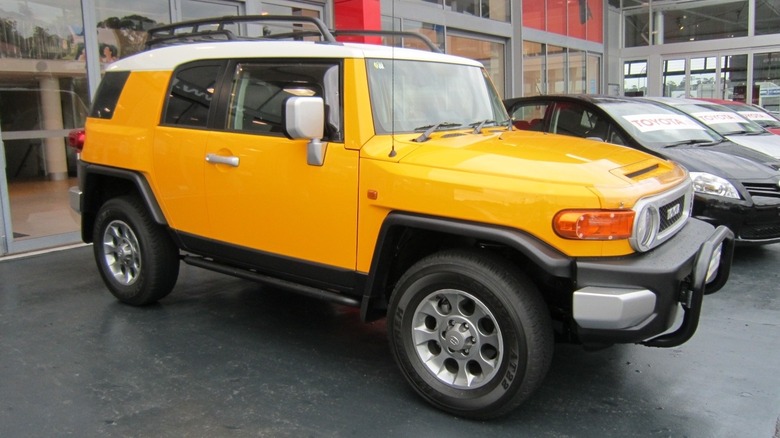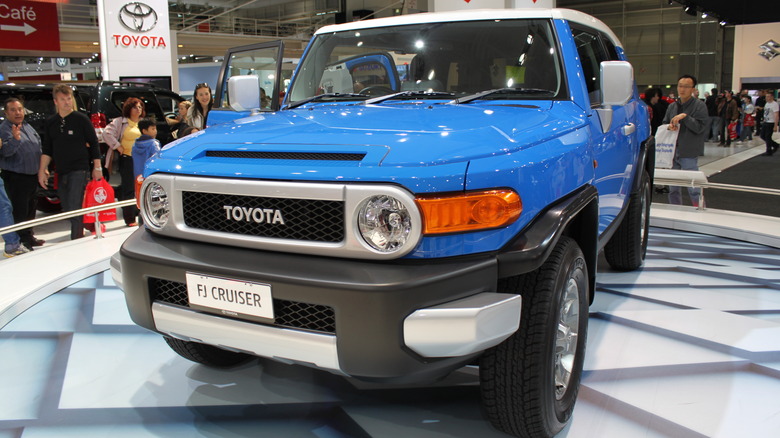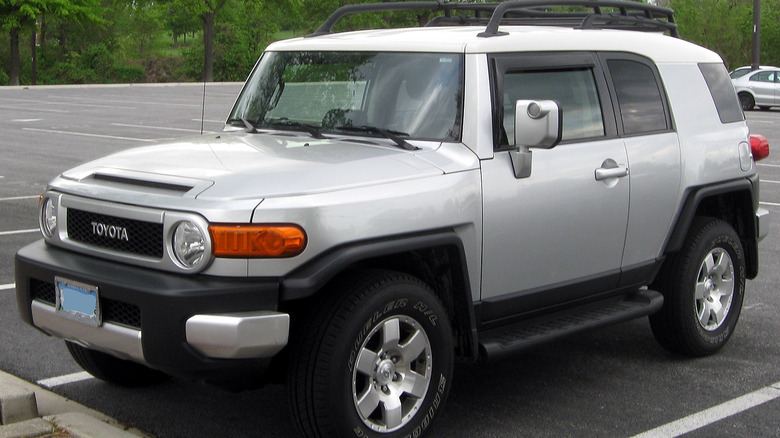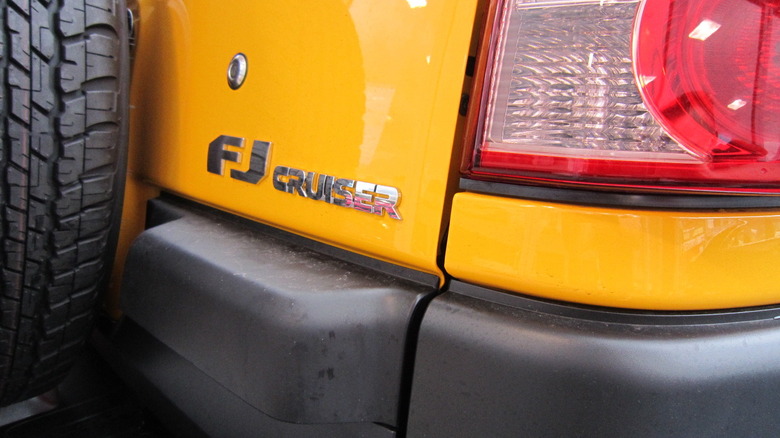Here's Why Toyota Discontinued The FJ Cruiser
Car companies cease production on their vehicles for a variety of different reasons. Oftentimes, it's because they've developed a newer, better vehicle with improved technology for performance, safety, and fuel emissions. Then there's always the possibility a car is no longer made simply because it didn't sell very well, and the automaker just needs it off its assembly lines to replace it with something more appealing to the marketplace.
The trouble is that a car company will rarely ever disclose and publicize exactly why these production changes are made. For example, one automobile that's never been officially commented upon in regards to its discontinuation was also one of the coolest concepts for a vehicle this century – the Toyota FJ Cruiser. This mid-size SUV was released for the 2007 model year, and though it started off as a fairly hot ride with its old-school look, it only made it seven years before being taken out of the United States market.
Because Toyota hasn't given official word on the matter, that leaves us the opportunity to speculate wildly on exactly why this vehicle is no more. Let's look back at the short-lived FJ Cruiser and see where the cracks were that made it such a quick scratch from Toyota's lineup.
What was the FJ Cruiser?
The FJ Cruiser was designed to be an update of the company's former FJ40 Land Cruiser, which was a part of its arsenal from 1961 through 1984. This 4x4 was an off-roading gem that's become one of the most beloved and coveted vehicles in the history of Toyota. This is particularly true in the U.S. because it had a fairly limited presence stateside despite its long production run. Granted, Toyota has never stopped making Land Cruisers, but the FJ40 remains a benchmark for the company.
So, in the early 2000s, Toyota decided to revitalize that SUV for the modern consumer, but in its design, the company still wanted it to have the rugged, retro look of the vehicle it was harkening back to. From that concept came the FJ Cruiser, which hit the scene for the 2007 model year. Outfitted with a 4.0L V6 engine — a bit different than the I6 engines that powered the FJ40 — the vehicle was something of an immediate hit. It tied with the Honda CR-V as the best compact SUV of 2007 by J.D. Power, and for the first two years of its life, it surpassed 55,000 units annually in the United States.
Toyota has a penchant for creating very reliable vehicles, and bringing that mentality to an 4x4 like this appeared to only be a good thing. As a result, everything started off swimmingly for the Toyota FJ Cruiser, but that honeymoon period ended up being the start of a failed relationship.
The decline of the FJ Cruiser
Despite the FJ Cruiser's incredible start, it quickly becomes evident why Toyota possibly thought there wasn't going to be a long life for the 4x4 in the United States. Those first two years of sales were quite strong, but that level of success couldn't be maintained. In its third year, sales were cut nearly in half to under 28,700 units total. The following year, that cratered even further to less than 12,000 units. It remain in the lower half of the 10-20,000 range for the rest of its run in America.
Why the sudden drop in sales? It could just be because it turned out that the market for a retro-feeling off-roader like this ended up being more of a novelty than expected, and all the folks who wanted one got it within those first two years. However, I don't think that tells the whole story.
Introducing a new vehicle for the 2007 model year was just about the worst time imaginable to do so. In October 2007, the stock market crashed, and we were about to be in the worst financial crisis that had been seen in a long time, which we now call the Great Recession. Unemployment was at an unimaginable high, and people simply didn't have money to spend, especially on high-priced items like automobiles. Even though the FJ Cruiser was moderately priced with a base MSRP of $22,755 (about $35,450 today), that's a ton of money during a time when it was so scarce. I believe this to be the ultimate factor.
[Featured image by IFCAR via Wikimedia Commons | Cropped and scaled | Public Domain]
The ultimate end of the FJ Cruiser
In its final year of production, the Toyota FJ Cruiser went out with a whimper, managing just over 11,700 units in sales. If a vehicle is selling that poorly, there are very few options left for an automaker like Toyota than to simply pull it from the marketplace, which is exactly what happened. The company did let it go out with an Ultimate Edition branding, but even that wasn't enough to make it surpass the sales from the previous year.
However, this was only for the American market. The FJ Cruiser was still available in various countries around the world — particularly in South America and the Middle East — up until 2022, though its numbers would gradually shrink as the years passed on. A 4x4 like the FJ Cruiser is simply a more common vehicle in those territories than the United States, but Toyota still felt the need to take it out of those places too. If a vehicle isn't servicing the United States or Japan, where it was discontinued in 2018, then Toyota has very little need to continue making it as those are the company's two biggest markets.
Though Toyota hasn't stated this, it all comes down to money, and if a product isn't making money, then a company is probably going to stop making it. It seems fairly obvious that the death of the Toyota FJ Cruiser was as simple as that.
[Featured image by Jeremy via Wikimedia Commons | Cropped and scaled | CC BY 2.0]



